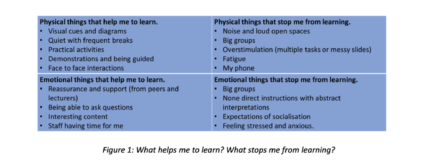UK higher education institutions are welcoming an ever wider range of neurodiverse learners who are increasingly presenting with more complex needs.
While it is becoming better understood, “neurodiversity” is still a blanket term covering many experiences. In practice, neurodiversity can refer to learning, mental health needs, or other health needs – as well as many more.
However, what constitutes “neurodiverse inclusion” can vary from student to student. A participant in our research exploring the experiences of neurodiverse learners during their studies said:
neurodiversity may be different in relation to social preference, ways of learning, ways of communicating and perceiving the environment.
Extent
Our research aim was to understand the preferences, strategies and methods that neurodiverse learners find helpful in developing their learning journey. By understanding their experiences, we wanted to share effective practice and suggest strategies to inform our teaching and learning to enhance the neurodiverse student experience.
Working with one of our final year students, we designed an online survey that was sent to all learners at the university – from first years through to PGRs – and asked them to explain in their own words what neurodiversity meant to them and how they experienced learning. The final sample included 25 students – 20 identified as female, four males and one nonbinary. Their age range was between 19 and 70, with the average age being 31 years old. We gave full autonomy to the participants to use a clinical diagnosis or a self-diagnosis to describe their neurodiversity.
While the survey went out to all students – as we wanted to invite the whole community to contribute under a broad definition of neurodivergence both with or without a formal diagnosis – all those that responded identified a neurodivergent need or as neurodivergent. In theory, any student could have responded and described themselves as neurotypical in their answers, but this was not the case.
Students varied in the ways they described their neurodiverse conditions. Some disclosed their clinical diagnostic status with accompanying terminology – such as dyslexia, ADHD, or autism – while others alluded to having a “super skill” or “a brain that works differently.” The spectrum of neurodiversity identified was vast, demonstrating the complexity of supporting neurodiverse learners in higher education.
Impact
Regarding how their conditions impacted their learning experience – comments were equally wide-ranging. There were some comments about the teaching and learning specifically.
I don’t do well absorbing and understanding teaching where assumptions need to be made, or if the information/fact isn’t absolutely clear…. leaves too many possible interpretations.
Some described the social difficulties they faced fitting in:
I have no friends. I find campus a very lonely place. I find the spaces very overwhelming and loud with nowhere else I know of that I can go and sit.
While some noted that a lot of misconceptions about neurodiversity remain
There is still a lot of stigma about this that we are “lazy”.
We categorised what neurodiverse students told us helped and what hindered their learning into physical and emotional criteria.
Physical and feel
Physical factors encompass a range of environmental factors that can impact learners. These included noise, smells, room size, interactions with others and the autonomy given to learners in the space, time and decision-making. These can enhance or hinder how neurodiverse learners experience access to their education.
While emotional factors are a complex issue, and we appreciate that many of these factors are out of the control of teaching staff, our neurodiverse learners did discuss how these can significantly change how they experience their learning.
Feelings of stress and anxiety can have adverse effects on neurodiverse learners, and being aware of how both physical and emotional factors can impact a learning space to adjust and predict challenging circumstances.
While we have categorised these separately, it is important to recognise that these can be intrinsically linked- for example, a loud space (physical) can elicit an emotional response (i.e. heightened anxiety).

This chart gives a context to planning teaching and learning activities and offers an understanding of the role the physical and emotional environment can play for all learners.
What helps?
The learning environment was very important, with many participants experiencing anxiety, overstimulation, or panic where they could not have regular breaks, ask questions, move around or take extra time to consolidate shared information. Participants also discussed sensory issues associated with large open spaces, big groups, smells, noise, or silence and where they were seated in the class. A safe emotional environment supports neurodiverse learners to feel more secure in navigating environmental challenges.
Many participants suggested that how the teaching material is presented heavily influences their engagement and understanding. Overcrowded, messy PowerPoint presentation slides were distracting and challenging to interpret. Similarly, tasks open to interpretation – such as the choice of topics in an assignment or vague instructions – could induce self-doubt and anxiety and lead to the need for further reassurance. Strategies that help to counteract these and connect their learning worries include:
- Clear, concise slides and instructions.
- Definitions and key points are clearly articulated.
- A context or worked example to show new theoretical models or learning.
Many learners suggested that having resources in various formats – such as video and digital artefacts – helped them engage more readily and made tasks more active and engaging.
By design
Our study highlighted the importance and responsibility of lecturers and professional support services in not making assumptions about the range of learners in a group of students. Accessibility by design ensures tutors are inclusive of the needs of their learners, and while anticipatory approaches may be used to better understand the nuances of neurodiversity, these, in turn, support all learners.
In fact, due to their self-proclaimed “super skill” of “thinking outside the box”’, our neurodiverse learners often contribute valuable insights and ideas to wider class discussions and debates that other learners may not have considered. Being inherently valued as a contributing member of the learning community can not be understated, and participants often mentioned this – and support from staff and peers – as contributing to their wellbeing.
We believe that the recommendations our neurodiverse learners have shared with us, if embedded thoughtfully, would then be able to enhance the learning environment and learning experiences for all students.















As an autistic person, I appreciate many of the points made in this article. I am also strongly supportive of the concept of neurodiversity, meaning that a society, or a species, benefits from including many different neurotypes (or ways of brains working). But neurodiversity is a feature of societies / cohorts / species, not a condition of individuals, and encompasses many different differences (as it were) that can’t be aggregated into a single condition called ‘neurodivergence’ (a term which, I find problematic because it is premissed on there being a norm from which to diverge).
I agree. In some disciplines what is often seen a “normal” elsewhere is in fact divergent from that particular disciplinary norm.
I totally agree with everything in this comment. There is very clear data that the genetic architecture of all of the conditions mentioned is very significantly a product of common genetic variation, which, by definition, is present throughout humanity, as discussed for example in https://www.frontiersin.org/articles/10.3389/fnmol.2022.930941/full.
Messy, disorganised slides and vague instructions are difficult for most people, neurodivergent or neurotypical, so addressing these issues has general benefits without individuals having to identify themselves as neurodivergent. Stigma about neurodivergence is very, very real. I would love as a staff member to be open about being autistic but it seems to make other staff members feel uncomfortable and behave differently around me. I then pick up on this due to strong affective empathy and it makes things even more difficult for me. Students, on the other hand, are much more accepting of difference. I would say that it’s important to remember that neurodivergent students become neurodivergent staff, but with only 20% of people with an autism diagnosis in employment that clearly isn’t the case.
Like the commenter above, I agree it’s important to get terminology right – neurodiversity relates to the population as a whole, neurodivergent is used to refer to the subset which is not neurotypical.
It’s so good to see the needs of neurodivergent students being taken into account and applaud the researchers for undertaking this work. However, I struggle with the interchangeable use of ‘neurodiverse’ and ‘neurodivergent’. Dr. Nick Walker effectively and compelling describes why using these terms interchangeably is oppressive by nature:
“The only appropriate and grammatically correct use of the term neurodiverse is when it’s used to describe a group of people whose members differ neurocognitively from each other. In other words, a classroom where everyone is Autistic is not neurodiverse, but a classroom where some students are neurotypical and some aren’t is neurodiverse.
In addition to being incorrect, it’s also oppressive to misuse the word “diverse” to mean “minority,” because this misuse of “diverse” is based in the intrinsically oppressive assumption that there’s a default “normal” way of being and that “diversity” is about adding non-normative individuals into the “normal” default environment. This is the assumption that allows tokenization to pass for “diversity” in corporations, schools, and other social institutions.”
https://neuroqueer.com/neurodiversity-terms-and-definitions/
For me, as an Autistic person, the neurodiversity paradigm comfortably encapsulates my values and lived experience. But if the language of this paradigm is going to be used more widely, the full nuance needs to be understood.
My comment is not an attempt to undermine this important work, but to support an increased understanding of neurodiversity and its glorious complexity.